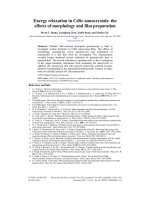Energy storage in photovoltaics
Bạn đang xem bản rút gọn của tài liệu. Xem và tải ngay bản đầy đủ của tài liệu tại đây (369.34 KB, 35 trang )
Energy storage in
photovoltaics
P.C.Pant
Scientist
Solar Energy Centre
Ministry of New and Renewable Energy
Nature of renewable energy supplies and
real challenge
Renewable energy supplies are continuing or
repetitive current of energy occurring in
natural environment
The initial input power from renewable energy
supplies therefore is outside our control; and
matching supply and demand in the time
domain is a real challenge
Two ways to overcome this challenge are :
Either matching the load to the availability of renewable
energy supply when it is available, or for constant load,
hybridize it with an auxiliary energy supply system
Storing the energy for future use i.e. keeping it available
when and where it is required
Methods of energy storage
Chemical
: hydrogen, ammonia
Heat
: hot water, steam
Electric
: Capacitors, electromagnets
Gravitational : water reservoir
Mechanical
: Flywheel
Photosynthesis: Biomass
Electro chemical: Batteries, fuel cell?
Normal applications of battery
Regular deep cycling (as in consumer devices,
electric vehicle)
Standby use (normally kept at full charge so as to
use in case of an emergency such as telephone
exchanges)
Starting, lighting and ignition (for road vehicles)
In all such operation battery is normally given
full charge (adequate overcharge) after
discharging.
Condition in PV systems
Limited (variable)amount of charging energy
available from PV array
Therefore no guarantee that battery will be fully
charged at the end of the day
Normally shallow cycle operation
Autonomy reserve for certain days is generally
specified
Even in specifying autonomy, there is certain
charge left in the battery (~20%)
Main functions of a battery in PV
systems
To act as buffer store to eliminate the mismatch
between available PV power and power demand
(USUALLY IN GRID INTERACTIVE
POWERPLANTS OR WITH AUXILIARY
POWER SOURCE WITH SMART INVERTERS)
To provide a reserve of energy (system autonomy
particularly in stand alone systems)
To provide stable voltage to the load
Understanding battery
Storage capacity: not fixed, depends on discharge rate
and temperature
Never try to extract full capacity (DOD)(restrict upto
80%)
More daily DOD, less cycle life
Battery voltage during charging depends on amount
of current being fed, higher the charging current,
faster will be the voltage gain, but does not mean that
all the current is absorbed
Temperature dependence of cycle life
In general, longer life of battery in PV system means
a more expensive battery, as higher capacity, proper
charge regulator and temperature compensation are
required.
Capacity
Normally measured in amperehour (Ah)
Defined as the maximum Ah a fully charged
battery can deliver under certain specified
conditions:
The end voltage
The discharge current (rate) at which the
discharge is carried out
The battery temperature
Efficiency
Amount of energy stored is measured in watthours (Wh). Energy
efficiency of a battery =
Energy in watt hours discharged
___________________________________________
Energy in Wh required for complete recharge
Battery capacity is measured in amperehour (Ah). The charge
efficiency or Ah efficiency is=
Ah discharged
________________________________
Ah required for complete recharge
Ah efficiency less than one means more charge is to be pumped than
the charge delivered by the battery. This has side effect in the form
of oxygen formation in +ve plate and hydrogen in –ve.
Depth of discharge/state of charge
Depth of discharge (DOD) : fraction or percentage of
the capacity removed from fully charged battery w.r.t.
nominal capacity
State of charge (SOC): fraction or percentage of the
capacity still available during/after discharge w.r.t.
nominal capacity
SOC
DOD
100%
0
75%
25%
50%
50%
25%
75%
0%
100%
However battery performs more than 100% of its
nominal capacity at discharge rate lower than the
nominal rate.
Self discharge rate
Loss of charge of a battery if left at open circuit
for appreciable time
Quoted as a percentage of capacity lost per
month at a specified temperature when starting
with a fully charged battery
Normally doubles for each 100C rise in battery
temperature
Cycle life
Cycling describes the repeated discharging and
recharging process that a battery undergoes in
service
Cycle life is a measure of number of cycle a
battery can deliver over its useful life
Quoted as number of discharge cycle to a
specified DOD that a battery can deliver before
its capacity is reduced to certain fraction
(normally 80%) of the initial capacity
Higher the DOD lower will be cycle life
A BATTERY STATED TO GIVE 1000 CYCLE AT 80% DAILY
DOD MAY HAVE PREDICTED LIFE AS FOLLOWS (THOUGH
THIS IS TOTALLY UNBELIEVABLE FOR VERY SHALLOW
CYCLING DUE TO CERTAIN OTHER REASONS:
Daily DOD (%)
Cycles
years
80
1000
2.7
40
2000
5.5
20
4000
11
10
8000
22
5
16000
44
2
40000
110
1
80000
219
Factors affecting the battery
life and performance in PV
systems
Manufacturing faults: choose a reliable and
trustworthy manufacturer
User abuse: providing documentation, proper
supervision, or training for commissioning
Accidents: being careful such as to avoid
dropping spanner across the battery terminals
Improper design of PV system: to avoid
sulphation (in the case of lead acid battery),
stratification and freezing
Possible remedy
Ensuring full charge (at least periodically)
Restricting to specified DOD
Providing as rapid a recharge as possible after
deep discharge
This can be achieved by:
Choosing an appropriate battery
Sizing it properly
Providing an appropriate method of charge
control
Controlling factors to the maximum
service from battery
Cycle life: a misleading notion
Grid corrosion: highly temperature dependent
(doubles for every 100C increase in temperature
in the case of lead acid battery)
Additional factors in sealed battery
Water or acid loss due to less than 100%
recombination of oxygen resulting venting out of
gas
• Positive grid corrosion
• Water vapour loss through case
Negative capacity loss: a chemical process rather
than electrochemical process
WHAT WE WANT
Looking at the factors explained so far, need to
have quality product
For assuring quality, need to have parameters to
measure that
For that proper specifications/standards are
necessary,which may cater requirement of all the
three types of lead acid batteries i.e.
flooded,AGM VRLA,Gel VRLA
Attempts have been made to develop such
specifications based on failure analysis of
batteries in SPV, effect of different charging
mechanism on battery performance, monitoring
and evaluation of different types of batteries in
actual field conditions, studying various
standards and than choosing the best from each
Circulated these to all the battery and PV
industries for their comments including SESI
Received comments were incorporated in the
draft now here for discussion and suggestions to
enable freeze the standards by the end of this
workshop with the recommendation that the
draft be adopted by BIS for batteties for PV
application by giveiong suitable BIS number
Recommendation about developing more test labs
with capacity to undertake third party testing as
per these specifications.
Thankyou
Component of a battery
Positive and negative electrode (plates)
An electrolyte
Separators to stop the electrode touching
A container
Positive and negative terminals
Types of battery used in PV
systems
Lead Acid:
very prominently
used
NickleCadmium
Nickle metal hydride
Rechargeable lithium of various
types
LeadAcid :Fundamental Principle
Fundamentally very simple to make
On hanging 2 metallic lead strips in and on
opposite sides of a small glass jar filled with
dilute sulphuric acid, connecting these strips
called ‘plates’ with a source of direct current and
allowing them to ‘charge’, the colour of one strip
becomes increasingly dark brown , called positive
plate; and other retains its original colour called
negative plate
On removing the charging source, a voltage of
about two volts is shown by a sensitive voltmeter
across the two plates called electrodes.
Fundamental Principle
A battery formed this way has no practical value
because of low surface area of the strip to
accumulate sufficient ‘active material’ i.e. brown
lead peroxide of the positive plate and metallic
‘sponge’ lead of the negative.
Fundamental Principle
The increase in effective area of plates for
achieving greater and greater capacity for
industrial use is one of the requirements for
useful design of the battery.
This can be accomplished by:
Casting plates with complex ridges or
grooves
Mechanically furrowed to obtain greater
surface
Separate corrugated lead ribbons are
rolled into spiral buttons and inserted
in lead alloy frames.
Fundamental Principle
Type of plate affects the characteristics and performance of
battery.
All types have lead di oxide (PbO2)in the positive plate
applied during manufacture and porous sponge lead (Pb)
on negative plate.
The positive plates are welded to form a plate group and
negative plates are assembled in the same manner.
The plates of different polarity are insulated from each
other by separators.
The complete plate group assembly is immersed in dilute
sulphuric acid in a container.
Thus an electrochemical couple of two different plates or
electrodes (PbO2 and Pb) in an acid electrolyte (H2SO4) are
all that is required to make a rechargeable, or storage
battery.









